|
|
Minerva Obelisk
| Present Site: | Piazza della Minerva, Rome (In front of Basilica di Santa Maria
Sopra Minerva) N 41°53'52.7"(41.897972) E 12°28'39.2"(12.477556) |
| Pharaoh: | Pharaoh Wahibre (Apries in Ancient Greek) (Third Intermediate Period of Egypt, 26th Dynasty, Reigned 6th Century BC) |
| Measurement: | 5.47 meters high for obelisk itself, 12.69 meters including the top decorations, elephant statue, the pedestal and the 4-step basement |
| Stone: | Red granite |
About The Site:
The square "Piazza della Minerva" is a small square which is in front of Basilica di Santa Maria Sopra Minerva.
This Basilica was built on the ruins or foundations of ancient Iseum (or temple of Isis).
Therefore, the Basilica must be called "Santa Maria Sopra (means "over" in English) Isis", but Egyptian goddess Isis was erroneously ascribed to the Greco-Roman goddess Minerva. Then, the Basilica was named "Santa Maria Sopra Minerva".
The religion of Isis spreaded throughout the paganism Roman Empire, and many obelisks were erected for the temple of Isis, as Isis was originally Egyptian goddess. This Minerva Obelisk is one of such obelisks which were brought from Egypt, others obelisks such as Agonalis Obelisk in Piazza Navona, Macuteo Obelisk in front of Pantheon, and Dogali Obelisk of near the Termini Station have been once erected for the temple of Isis.
Although the temple of Isis in Rome is completely lost, but the one still partially remains in Pompeii Ruins. The Worship of Isis was illustrated for the explanation at the site. (See the picture.)
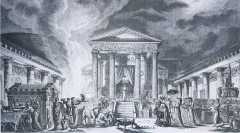
The Worship of Isis
Illustration at the temple of Isis, in Pompei Ruines. |
How To Get There:
The nearest Metro station is Barberini on Line "A", but it's about 700 meters by walk. In the case of bus, Bus #64 for P.za Stazione S. Pietro stops at Largo Torre Argentina. Getting off here, and then 200 meters North by walk, you can reach Piazza della Minerva.
Since this is close from Pantheon, about a little more than 100 meters, I would recommend to come here after visting Pantheon. Walk through the left side street (Via della Minerva) along Pantheon, soon you can see the Piazza della Minerva.
About The Obelisk:
This obelisk is small of 12.69 meters high as a whole including the pedestal, and only 5.47 meters for obelisk itself. Originally this obelisk was erected as a pair at Sais, a town in Nile Delta region by Pharaoh Wahibre (well-known as Apries in Greek name) of Third Intermediate Period of Egypt, 26th Dynasty. Sine the capital is seated in Sais at that time, the 26th Dynasty is also called "Sais Dynasty".
Although Pharaoh Wahibre is not well-known Pharaoh, he was son of Psammetikos II, and reigned in 589 - 570 BC. His head made by black granite is stored in Louvre Museum.
These 2 obelisks were brought to Rome, probably in the 1st century, and considered as erected for Iseum (or temple of Isis), however, no reliable records exist.
This obelisk was discovered in 1665 around here, and then re-erected by Pope Alexander VII [Alessandro VII in front of Basilica di Santa Maria Sopra Minerva, the current site.
The feature of this obelisk is on the statue of elephant, which was designed by Giovanni (Gian) Lorenzo Bernini (1598-
1680). With this unique statue, this obelisk is known as a small and pretty one.
SAPIENTIS AEGYPTI INSCULPTAS OBELISCO FIGURAS AB ELEPHANTO BELLUARUM FORTISSIMA GESTARI QUIS QUIS HIC UIDES DOCUMENTUM INTELLIGE ROBUSTAE MENTIS ESSE SOLIDAM SAPIENTIAM SUSTINERE. Note: Original letter V is transcribed to U |
On the side of pedestal, the provenance is written in Latin: "It was re-erected by Pope Alexander VII in July 1667". And on the another side, a kind of apothegm is written, which means "Let any beholder of the carved images of the wisdom of Egypt on the obelisk carried by the elephant, the strongest of beasts, realize that it takes a robust mind to carry solid wisdom." (Source: Labib Habachi: The Obelisks of Egypt, p.130, The American University in Chicago Press, 1984). This may seem like a forced expression, but this would probably be the theme that Bernini figured out.
As stated above, these 2 obelisks were probably erected for Iseum (or temple of Isis), then toppled at unknown date, and buried underground. After discovery in 1665. another pair of this obelisk is erected in Urbino, a small town in Italy, and is still there. Visit "Urbino Obelisk" for the details.
The hieroglyph of one line (column) is inscribed on each face.
The conservation status is basically fair, except the north side, and the horus name and coronation name of Pharaoh Wahibre are readable.
Notes For Pictures:
I could take an ample time for taking pictures because here is not a tourist's interesting spot, and like a back alley, little people is always around here even in the day time. Since I forgot to take a picture of north side of the obelisk in summer 2013, I revisited here in the next year, a tourist group was unusually here.
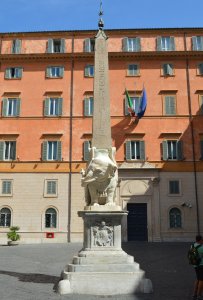 South Side |
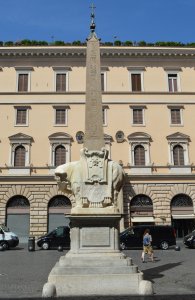 East Side |
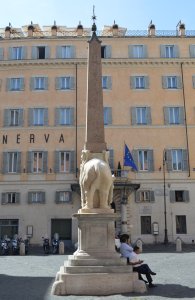 North Side |
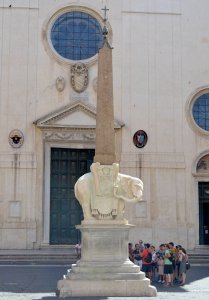 West Side |
|||
August 11, 2014 by Hiroyuki Nagase (For high definition image, please click the picture) | ||||||
Copyright Hiroyuki Nagase nagase@obelisks.org and Shoji Okamoto okamoto@obelisks.org